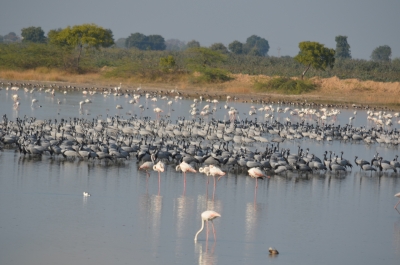
The Ministry of Environment, Forest and Climate Change designated four wetlands to the list of Ramsar Sites – two each from Haryana and Gujarat. They are the Thol Lake Wildlife Sanctuary and the Wadhwana Wetlands from Gujarat and Bhindawas Wildlife Sanctuary and the Sultanpur National Park from Haryana. With these additions, India is now home to the largest network of Ramsar sites (46 in all) in South Asia. A Ramsar Site is a wetland designated to be of international importance under the Ramsar Convention, established by UNESCO.
India ratified the Ramsar Convention in 1982 at the behest of the then Prime Minister, Indira Gandhi, who is also credited to have heralded several key environment legislations in the country. Keoladeo National Park and Chilika were the first two sites to be placed on the Ramsar List by the Government of India initially. Till 1990, only four more sites were added to the list and another 19 over the following two decades. Since 2010, Ramsar Site designation has received a significant policy push from the MoEFCC, and 21 wetlands added to the list in the last decade alone. The network of Indian Ramsar Sites covering over 8% of the known wetlands’ extent of the country and is the largest in South Asia.
The Ramsar sites in India are highly diverse. The sites range from Himalayan high-altitude wetlands (Tso-Moriri, Tso kar complex and Chandertal), lakes and marshes (Wular, Hokera, Renuka, Keoladeo, Kabartal, Nawabganj, Loktak, Deepor, Rudrasagar, Sandi, Saman, Keshopur-Miani, Sultanpur, Nalsarovar, and Sasthamkotta), river stretches (Upper Ganga River stretch, Beas Conservation Reserve and Kanjili), crater lake (Lonar), salinas (Sambhar), mangrove swamps (Sunderbans, Bhitarkanika, and Point Calimere) and lagoons and estuaries (Chilika, Ashtamudi and Vembanad-Kol). Water storage areas (Pong, Harike, Bhoj, Surinsar-Mansar, Bhindawas, Sur Sarovar, Asan, Wadhvana, and Thol) and assemblages of sewage-fed fish farms (East Kolkata Wetlands) have also been included in the list by the Government of India. While the smallest Ramsar Site is just 49 ha in area (Chandertal), the largest, the Sunderbans spans 0.42 million ha.
Credit : Mongabay
Picture Credit : Google
Leave a Reply